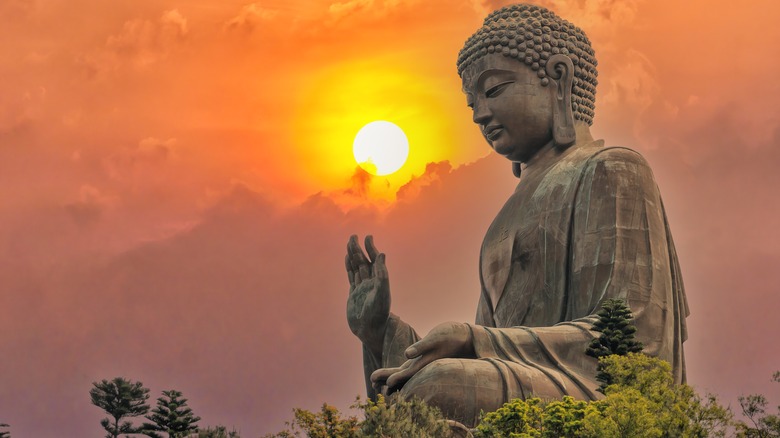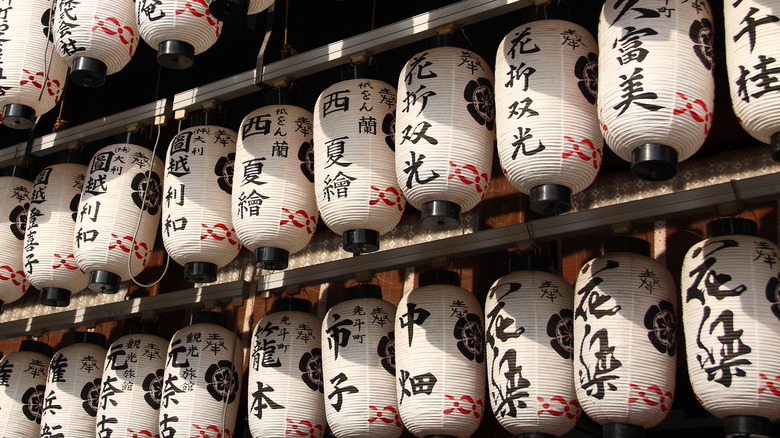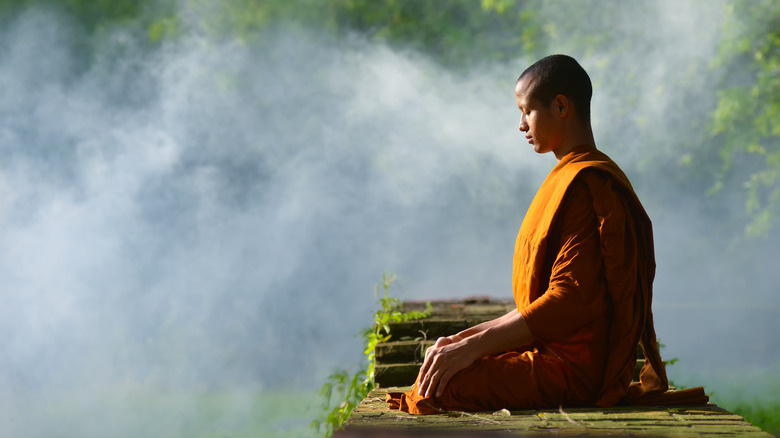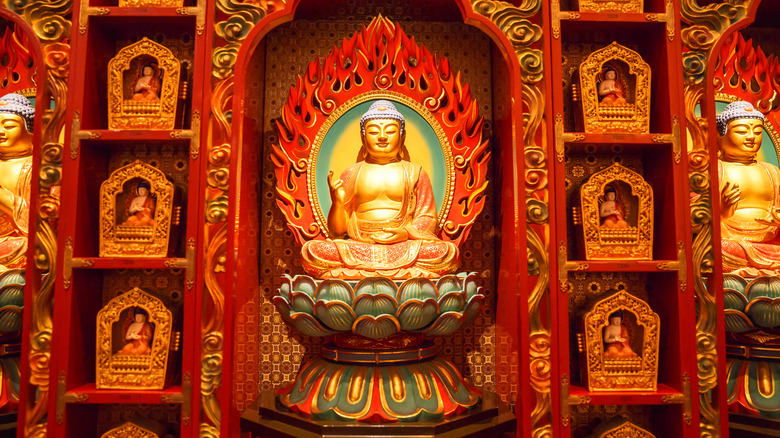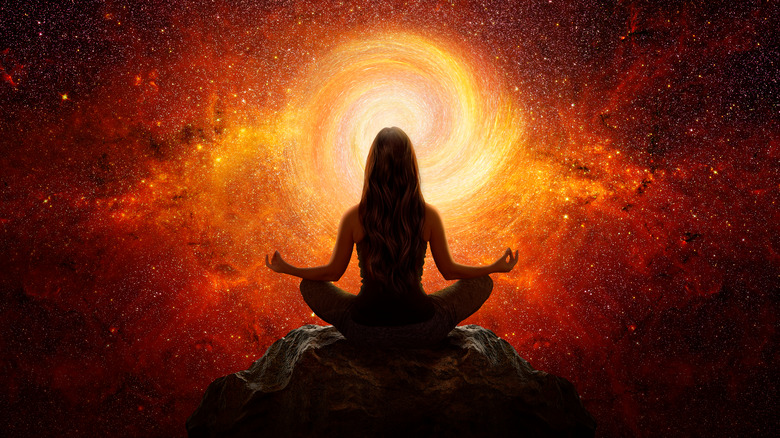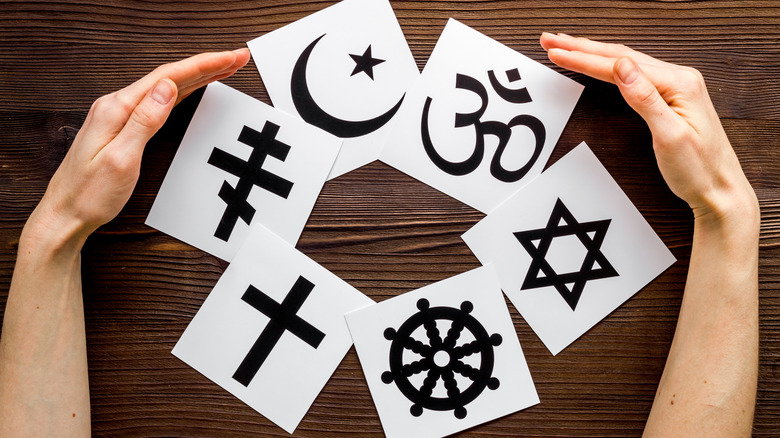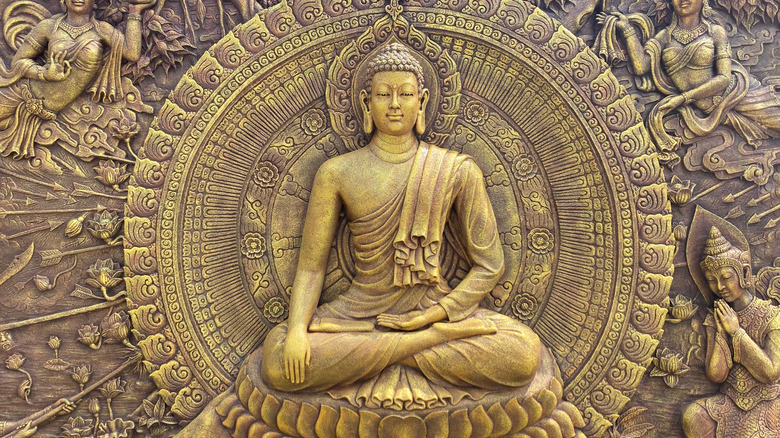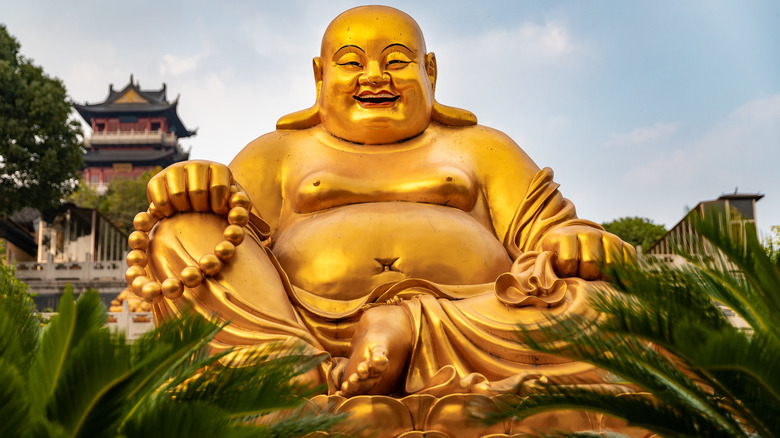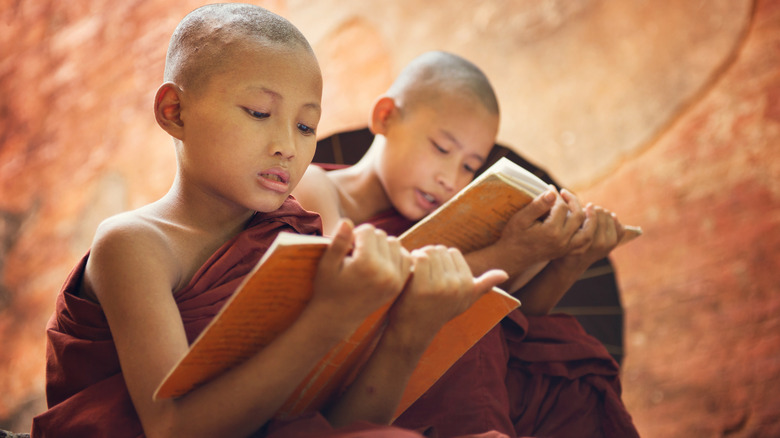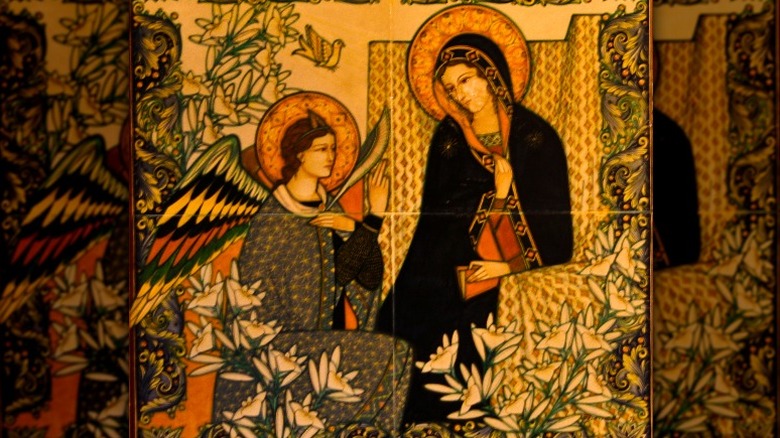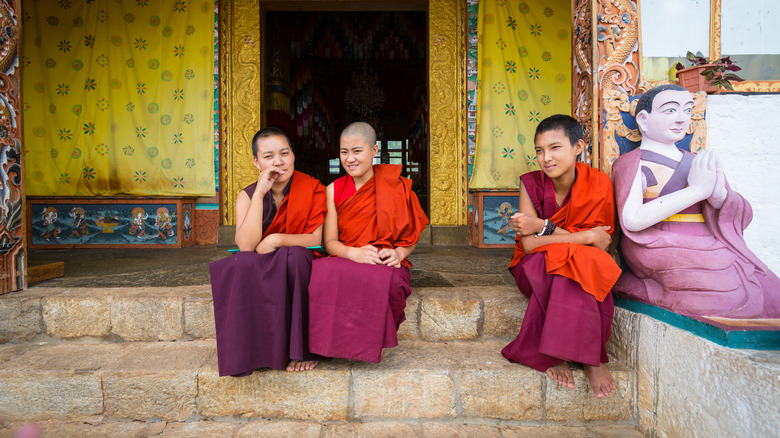The Untold Truth Of Buddhism
Buddhism is far and away one of the most popular religious practices out there, and given the sheer accessibility of it, that should be no surprise. According to Diamond Way Buddhism, to become a follower of the Buddha is simply changing one's perception. Given the number of texts that teach the Buddhist path, however, the beginning point will vary, though the accessibility never does. In fact, as History puts it, you can even practice Buddhism in your own home. There's no church, no temple, nothing like that.
According to Asia Society, the practice of Buddhism has evolved immensely over the millennia. At its foundational core around the sixth century B.C.E., it was one man finding the right way to live life by avoiding both ends of extremes — excess and dearth. It worked so well that it seemed worth spreading to others, which this particular individual ended up doing with the help of his disciples after his death. Just like that, Buddhism was well underway. Now composing just over 6% of the world population, Buddhism has some 500 million followers all over the world.
With how many changes have come about in modernity, it's hard to keep track of everything that is, isn't, or might (not) be Buddhist. Here's a look at the untold truths of Buddhism.
Buddhism is a made-up word
While Buddhism itself was founded between the sixth and fourth century B.C.E. (via Britannica), the actual word "Buddhism" didn't come around until over two millennia later. It wasn't until 1810, according to the Etymology Online Dictionary, that the Western world put together a fancy word for the package, adapting it from the Sanskirt word "Bauddha," meaning a follower of Buddha. After false starts with words like Boudhist and Bauddhist, they finally settled on Buddhist.
It's a similar story for the word "Buddha," which didn't pop up until 1680. It's derived from the Pali dialect meaning "awakened" or "enlightened." According to PBS, the more common expression in the east is "BuddhaDharma." For the earlier followers of Buddhism, and carrying on into today, the focus is on the individual and finding enlightenment in oneself — not in applying titles to the practice of Buddhism as a whole. As PBS puts it, the term is really only for the benefit of Westerners.
There are two types you can follow
Buddhism has two basic paths that can be followed towards enlightenment, according to BBC. The first is Theravada Buddhism, which is the conservative branch. The goal behind Therevada Buddhism is essentially to become a perfected human being who has followed the Eight-Fold Path (Buddha's teachings to end suffering). Many Theavada Buddhists are nuns and monks, as it requires complete dedication to the cause. Their end goal is to break the reincarnation cycle and reach nirvana, thus becoming Buddhas themselves and never again requiring rebirth.
The other branch is Mahayana Buddhism. Mahayana Buddhists take the other approach, utilizing the Six Perfections (or areas of human character) for the good of others. They aren't in it to break the reincarnation cycle. Rather they want to keep getting reincarnated to help others achieve their enlightenment — thus making followers of this path on track to become Bodhisattvas, which are people who could achieve nirvana but don't in order to help others.
So, essentially, Theravada walk the path themselves and break free from the cycle of rebirth. Mahayana take a more selfless route of assisting others.
Buddha's tooth has power
It's not exactly rare for religions to have relics of their holy people. The Christian church has so many they've got reliquaries all over the world with bits and pieces of holiness — John the Baptist's head, St. Paul's chains, the Shroud of Turin, so on and so forth. In that sense, Buddhism is no different. They, too, have relics of the first Buddha.
One in particular — the Buddha's tooth — is rather peculiar, however. Unlike other religious relics that by and large remain the same no matter how long they're on this earth, the Buddha's tooth housed in Rosemead, California, is still growing and has now reached 2-inches long, according to NBC. This tooth has healing powers and is on display along with a hair that moves on its own and 10,000 crystals extracted from the remains of the Buddha.
Other than the tooth, the hair, and the crystals in California, there are plenty of other relics sacred to Buddhism as well, as documented by Britannica. They note that, on the death of the original Buddha, nearly a dozen relics were saved, including some directly from Buddha's remains and salvaged from his ashes.
Buddhists don't believe in a god
Most belief systems give way to a superior being — a god that created all of this, oversees it, and in one way or another tends to it. Christians have the Holy Trinity, Muslims have Allah, and even tracing back to the Greeks, Romans, Egyptians, and more — they all have gods that are superior beings. And those gods determine the fate of the world, the fate of individual mortals, or sometimes they are hands-off and just deal with the question of what happens after death. But the point is — there is a higher power.
Not for Buddhists, according to BBC. They don't have a god at all. Not even the original Buddha is divine. The whole idea behind Buddhism is the power of oneself and achieving the utmost of the mind and body. Which all contributes to reaching nirvana, the perfect state where a human being breaks the reincarnation cycle and is in perpetual bliss.
As such, there's really no need for a god at all, since everything rests in the power of the individual. While practically every religion includes some sort of "be a good person" clause, helped on by something like the Christian Ten Commandments, there is often an added requirement of divine servitude of some sort; but not with Buddhism.
Buddhism isn't really a religion
This is something that is still debated and really comes down to a matter of interpretation. Since there is no god to worship and a set of personal tenets to follow, it doesn't meet the criteria of other world religions.
The Guardian explores what Buddhism really is, what it lacks, and how that affects how it's defined. What they settle on is that Buddhism lacks the spirituality that can be found in other religions. They even pull in the opinions of contemporary Buddhists, who reaffirm that there is nothing religious about Buddhism at all. It's actually more apt to describe it as a philosophy.
PBS backs this theory up, stating that calling it a religion just doesn't feel completely accurate. Instead, they double down on calling it a philosophy, noting that much of the texts center on ethics, which is also a branch of classical philosophy.
That said, the explanation of what Buddhism is doesn't end with philosophy either. It could also be considered part psychology, though it does not have any self-improvement aspect. After all, Buddhism is all about breaking down the concept of self, not necessarily improving it. It also has pieces of science and more, but the end result is simply that it is not an easy thing to define, and that makes it easy to say it's not definable as a religion.
Buddhism can combine with other religions
One of the truly unique aspects of Buddhism is that it is commonly combined with other religions, though the efficacy of this practice is still hotly debated. This traces all the way back to the spread of Buddhism in Japan in the sixth century. According to Japanology, Shinto always existed in Japan, and Buddhism came much later. Both espouse a way of living, so it's no wonder that over the centuries, the two coexist, and that can be seen in other combo packs with Buddhism as well.
Hindu Buddhists are perhaps the most common, as seen in HuffPost, and given the proximity of their development in Southern Asia, that makes sense. The same goes for the combination of Buddhism and Taoism, according to Buddha Weekly. However, with some religions, particularly monotheistic religions like Christianity (via the Guardian) and Islam (via Islamic Studies), it's less clear, as the combination of religions is less definitive.
It's also a matter of who's being asked. While some religious leaders may say that one can't be both Buddhist and another religion, there are still examples of followers who pulled it off.
Karma is not (always) a b***h
In the modern, populist vernacular, karma is often used to describe comeuppance or someone getting what they deserve. If you do something bad and it comes back to bite you, it's likely you'll hear something along the lines of "karma is a b***h." And if you really want to boil a complex subject down, you could do far worse than this assessment, according to BBC's definition of the Buddhist concept of karma.
The actual definition of karma is much deeper than that. At its core, yes, it means that our past actions have repercussions in the future, so the modern saying applies in most cases. If you are good to someone, it will lead to good things in your future, and if you're bad to someone, it will lead to bad things in your future.
The word karma means "action," according to BBC. And they go on to describe, karma isn't really a punishment that's dealt out but rather something that simply happens as a natural law like gravity.
That gets to the key difference between the popular saying and what it actually means. Karma is not vengeful or reactionary. It's "not an external force" but rather like a boomerang — the completion of a singular action. So yes, karma can snap back like the saying says, but to leave it at that shortchanges the richness of the process.
Anyone can be a Buddha
According to StudyBuddhism, a person is a Buddha when they've perfected the self and become the best possible human being that they can be — essentially, too good for this world. (In a good way.) Which is the whole purpose of following the various tenets and texts of Buddhism in the first place.
That's just the journey portion of Buddhism. The destination — the purification of oneself and full realization of potential — is becoming a Buddha. Meaning that anyone can become a Buddha. That may seem like a daunting idea to anyone familiar with the traditional monotheistic religions, mostly because of the misconception of who and what the Buddha is, but plain and simple, it can be anyone so long as they complete the journey according to whichever path they subscribe to.
Buddha isn't a chubby, smiling, bald man
Most people probably feel like they can recognize the Buddha at a glance. He's that smiling chubby guy sitting with his legs crossed, looking really friendly, often atop the counter at the local Chinese food restaurant. That isn't the Buddha at all, though he is a Buddha.
According to Denise Leidy, curator of Asian art at the Yale University Art Gallery (via HowStuffWorks), "In Christianity, there's this one guy. So when people see this corpulent, fun guy, they think, 'That's the Buddha,' but it's not." Leidy adds, "The Buddha, in the singular, is Siddhartha Gautama."
The thing is, Buddhism has expanded since the days of Gautama to include many more Buddhas. The more aptly known "Laughing Buddha" was actually based on a Chinese monk named Ch'i-t'zu, according to Learn Religions. The story of Ch'i-t'zu has humble beginnings — he could predict the weather and other small miracles. As he became more popular in China, he evolved into a Santa Claus-like figure. Known as Pu-Tai, he is often depicted handing out sweets to children.
Ch'i-t'zu followed the spread of Buddhism further East, even taking it into Japan where he became known as Hotei. The Japanese loved that him so much that he became one of the Seven Lucky Gods of Shinto.
The Buddha is not essential to Buddhism
The Buddha's image is stamped all over modern, mostly Western, interpretations of Buddhism — from the numerous statues and carvings of various Buddhas, to the Laughing Buddha. One thing to remember is that the Buddha is in no way a vital component of Buddhist teachings or followings — no matter the path the follower takes towards enlightenment. All Siddhartha Gautama did was achieve enlightenment first, so while he is a great role model for followers of Buddhism, he doesn't require any sort of worship, sacrifice, or prayers.
As History points out, Gautama is simply the founder of the principles of Buddhism, but he is not a deity.
Buddhism is all about the individual seeking enlightenment, and they can do that all on their own with the various paths of Buddhism. They can even practice in their own homes, according to History, meaning that it isn't even necessary for Buddhists to congregate or practice with others. This separates Buddhism from practically every other world religion, since so often the act of worship is essential.
There is no central text
Christianity has the Bible, Islam has the Quran, but Buddhism doesn't have a centralized text. In fact, most of what's compiled in the tenets of the various Buddhist texts are just collected teachings of various Buddhas. As can be seen on the Internet Sacred Text Archive, the complete list of Buddhist texts is expansive, and it varies between Southern teachings and Northern teachings.
These works are known as Sutras, which World History Encyclopedia defines as collections of teachings meant to guide followers on a path. The "Tripitaka" is the collection of the Buddhists teachings by his students after his death and is split up into "the "Vinaya," the "Sutta Pitaka," and the "Abhidhamma." These categories provide codes of conduct for nuns and monks, as well as the explicit teaching of Buddha with accompanying analysis.
There is another collection of 38 sutras that fit into the "Prajnaparamita," of which the "Diamond Sutra" and the "Heart Sutra" are the most popular. None of this even touches the principles of Zen Buddhism, which is it's own thing entirely.
The Buddha is a Catholic Saint
In a proper display of how interchangeable Buddhism can be with other religions, Christianity actually found out long after the fact that their Saint Josaphat was also the Buddha himself. All the more appropriate because Marco Polo, of worldly circumnavigational fame, wrote in his travelogues (via The Conversation) that the original Buddha, Siddhartha Gautama, "would have been a great saint ... for the good life and pure which he led."
About 150 years later, an editor of Polo's book read about the works of this Gautama and documented the similarities between his exploits and that of the Catholic St. Josaphat, according to The Conversation.
Yet, the parallel wasn't completely figured out until Buddhism spread to the West. Which is when everyone started to notice that the similarities were too much to be mere coincidence. The stories of both Josaphat and Gautama find each one secluded but soon encountering disease, death, and old age. They both abandoned wealth to embrace poverty before realizing that a middle path is desired.
Nine hundred years after the canonizing of the great St. Josaphat, Christianity realized that he was, in fact, the founder of Buddhism.
Buddhisms complicated history with women
While Buddhism is generally very receptive of all cultures and religions, there have been some issues with the Buddhist handling of women within their tenets. According to Learn Religions, women have been regularly discriminated against for centuries. Yet, according to legend, the Buddha's own cousin asked Siddhartha Gautama if women could enter Nirvana, and the Buddha said there was no reason at all.
Which is why it's hard to understand why Buddhism has more rules for nuns than monks, including the requirement of total subordination to monks. And this is when it can be problematic that there is no central text to Buddhism, because different sutras say different things. For instance, some teach that there's not really gender, while another contains text that seems to mean Nirvana only accepts men, so women must be reborn as male.
All that dispute aside, there have been plenty of women to reach enlightenment, so while the divide is still in text, in practice it seems that the barriers aren't as heavy in the West as they are often seen in the East.
